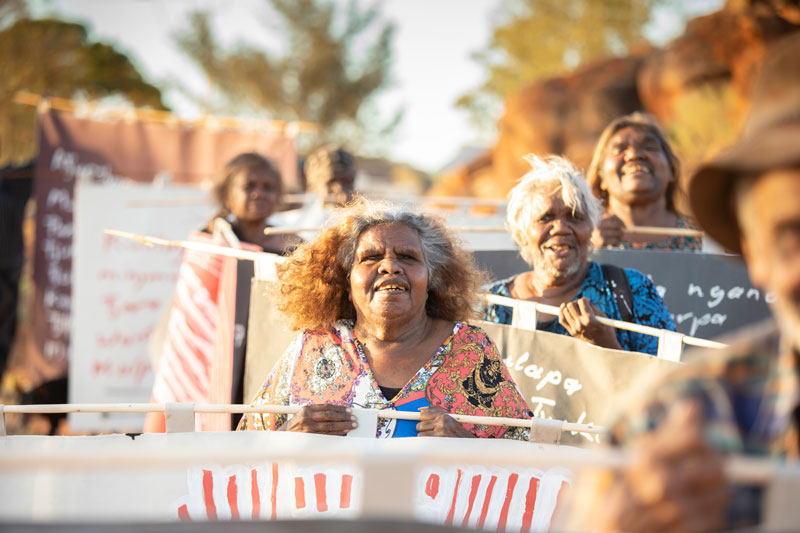
Opportunities for the desert Aboriginal art centres have fallen like dominos in the wake of the coronavirus pandemic. The experiences are far from uniform, as each art centre is on its own life cycle. Some have been hit at a fragile moment, while others, in a more robust phase, have nonetheless had to swallow big disappointments. They are all adapting as best they can—as one manager said to me, “Aboriginal people have a history of adapting to change, they’ll get through this.” But, as for so many others around the world, the longer the restrictions and uncertainty last, the harder it will become.
In the first weeks of March, some artists were far from home, getting ready for the opening of the Biennale of Sydney. They hailed from Tennant Creek, the highway town 500 kilometres north of Alice Springs, from Alice itself and close-by Ntaria, and from Mimili in the Anangu Pitjantjatjara Yankunytjatjara (APY) Lands of the far north of South Australia.
The novel coronavirus was well and truly on the horizon when they had left, with the first Australian death at the start of the month. By the time the Mimili group travelled a few days later, they were concerned enough to get a health check, had familiarised themselves with the safety routines and were carrying a good supply of hand sanitiser. Through the second week, as they were in Sydney supervising the installation of their work and taking part in the Biennale’s VIP viewing, infection numbers were climbing steeply. Australia had not yet closed its borders, nor moved on specific measures to protect remote Aboriginal communities, but it was not hard to see their particular vulnerability to a virus that spreads like wildfire in overcrowded conditions and holds greater risks for people with underlying ill health. The artists were busy and excited but also worried.
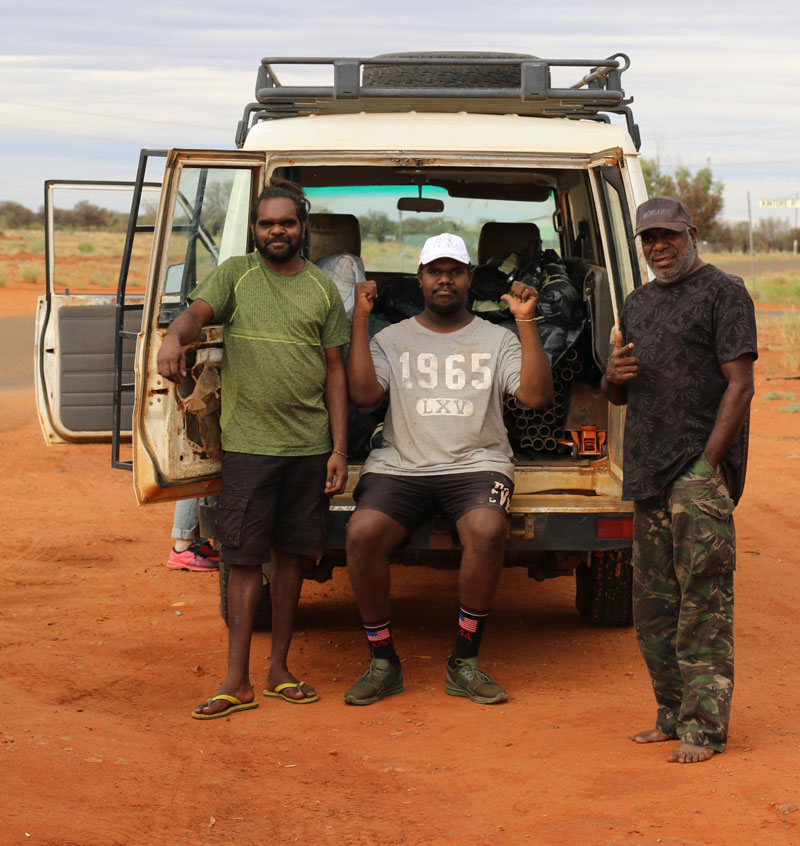
Back in the Centre, west of Alice, the Papunya Tjupi art centre was in full swing after a difficult start to the year. Following the death of one of their senior artists, Kumunjayi Nangala, the centre closed for all of January and into February, opened for a while, then needed to close again for Kumunjayi’s long-delayed funeral. When they finally reopened, everyone was just bursting to paint again, none more so than the young men who had been relishing Papunya Tjupi’s new men’s space launched last year and had plans to host two exchanges in the coming months with male artists from other desert communities.
The senior women artists were painting towards a show opening late April at Raft Artspace. Working on big canvases, passing paint between them, they were excited about the body of work they were creating. Arts worker Sharon Butcher was looking forward to an upcoming professional development trip to Sydney and Darwin. And preparation had begun for everyone to do a big bush trip in April, a generative painting camp, as the artists had done previously at Kalipinypa, a Water Dreaming site well to the west. This time they hoped to go out to Doris Bush’s country, at Nyunmanu, a Dingo Dreaming place.
Then the coronavirus meetings started. “At first we were worried for the business and thinking about different strategies for staying afloat,” says manager Emma Collard. “It didn’t hit us until a week or so later, the broader potentially catastrophic health concerns and that we were really looking at imminent closure.”
For the Mimili Maku artists the Biennale offered the first public showing of their biggest project to date, Kulilaya munuya nintiriwa (Listen and learn), two years in the making. They won’t say “culmination” because that will come next year, on Country, a show for all the APY communities of this response to the work of the late Kunmanara Mumu Mike Williams.[1] Before his death in March last year, he had planned for the Biennale his boldest political protest show ever, with banners and flags hanging throughout Sydney and in all the major galleries. After his death, the idea was taken up by his widow, artist Tuppy Goodwin, and his best friend and collaborator, spear-maker Sammy Dodd.
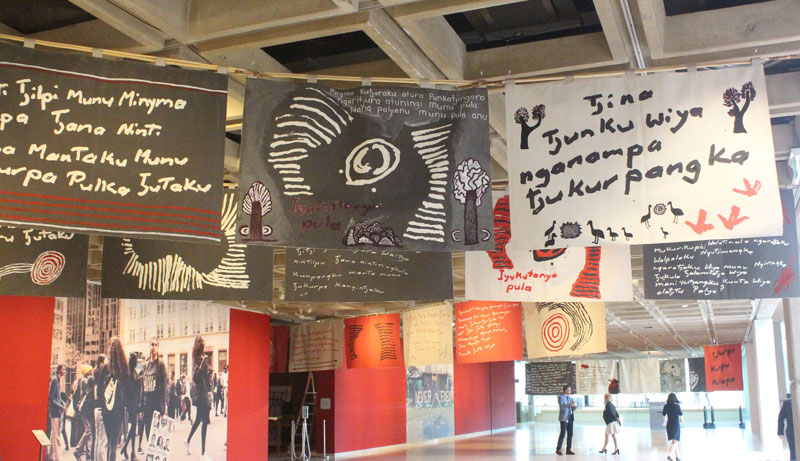
“His Tjukurpa is huge,” says Tuppy Goodwin, “it covers all of Australia. He left it here (on the earth) for us to pick up ... Australia’s Tjukurpa, Iyukuta Tjukurpa.” She and Dodd made a selection from Kunmanara’s personal and public political writings and had the texts printed on both sides of 36 large canvas banners. Then they gathered artists and community members at a big bush camp to paint onto the banners their responses to the texts. This became one of the key works of the Biennale, hanging in the foyer at the Art Gallery of New South Wales. Augmented Reality technology allowed viewers to see a digital version of the work on their device, with Kunmanara’s texts translated from Pitjantjatjara into English.
Young Alex Baker, employed as an arts worker at Mimili Maku and who travelled with the artists, was excited to think about what he could do with AR technology in his own nascent work. He also got to hang out with the thrillingly hard-to-categorise Brio from Tennant Creek, who work like no other artists out of the desert. This could also be said about the highly innovative Kunmanara, but he cleaved in life and in his work to Country and Tjukurpa; they were central. The Brio bring both—indivisible in the Aboriginal world view—into a startling dialogue with the urban and industrial economies and cultures that they live in now.
.jpg)
The Mimili Maku group were booked to go home on the Thursday before the Biennale opened to the public on Saturday 14 March. By then, there had been three reported coronavirus deaths in Australia and 175 reported infections, though fewer than 20 of them were in South Australia, and none in the APY Lands. The NT had its first cases but there were none in Central Australia. Still, news of the frightening escalation in countries overseas was enough to have everyone feeling increasingly anxious. The Brio had planned to perform at the opening. They met to discuss whether to stay or go. They stayed, performing for enthusiastic but relatively thin audiences, before leaving on Sunday, several days earlier than planned.
By 24 March the Biennale had to close the doors on its multiple venues, and shifted to doing its best to engage audiences online. The Brio are philosophical but it was a big disappointment. Their work is all about a visceral encounter and for the Biennale the artists had worked more collaboratively than they had before, in the process becoming very clear about what they have to say. Jimmy Frank and Joseph Williams’s punishment spears plunging through a defunct poker machine with Marcus Camphoo’s gridding in paint reclaiming its surfaces capture it succinctly. “We are the living history,” as Frank puts it, giving this title to the installation.
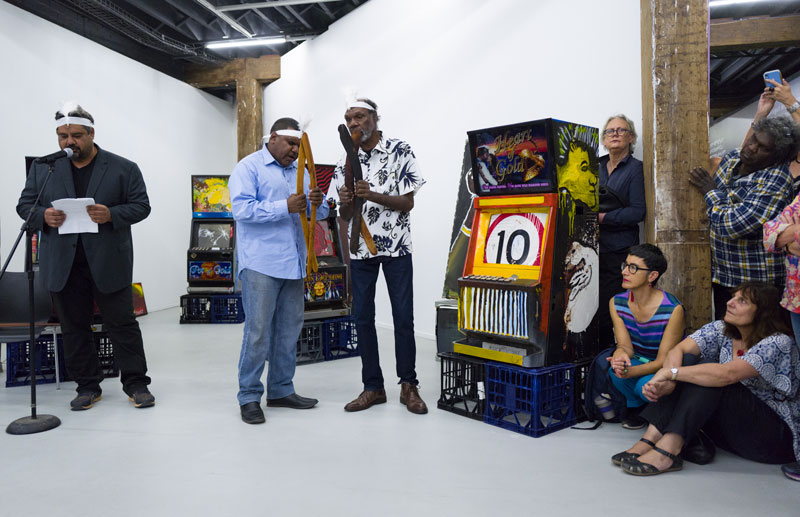
That history is about origins but it’s also about massacres and mining, about the greed that came to their Country and failed to recognise the Warumungu as its owners. In the 21st century, “it’s about moving forward, making new things happen” but not without the truth-telling, insists Frank. This may touch on issues that are pretty sensitive for some people but the truth “hasn’t been told enough, the bad stories.” “It’s not about dwelling on it, it’s about bringing out truth, in order to move forward and better our community, our nation.” Frank is worried some people might want to sit on the process, including some from within his own community. “How do we convince our elders in the community that this is a new way of doing art?” he asks. “How can we support this new way of art? I’m really concerned to maintain that.”
The Brio don’t have an art centre as such, and efforts to protect the town from the coronavirus and comply with restrictions are sucking up the available resources. There’s currently no money for the men to work with non‐Indigenous artist Rupert Betheras, catalyst, mentor, as well as member of the group, exhibiting alongside them. And previously where the artists had access to three sheds that served as their studios, now there is only one, which under social distancing limits means that only two can work at any one time. Fabian Brown and Clifford Thompson have been showing up regularly.
The town’s Nyinkka Nyunyu Art and Culture Centre has been crucial in supporting the artists and getting their work out into the world. Its doors are shut now too, of course, and its budget limited to maintenance levels. Jimmy Frank is employed there and in his steady way speaks of using the shutdown to get organised so that “when everything comes back to normal, we can hit the ground running.” “It’s reminded me how tenuous things are,” says Nyinkaa Nyunyu manager Erica Izett, “made me more aware of what has happened to Indigenous people over and over, how major disruptions come in from the outside, rendering them not in control of their own destiny.”
For all their tough allure and dynamic energy, this group of artists, of those I spoke to, seem the most vulnerable to the coronavirus impacts, being both relatively new on the scene (their first show was in 2016) and missing the protective factor of an art centre with stable staff and funding to support their practice. Like the Brio, Iltja Ntjarra and Mimili Maku had the Biennale rug pulled out from under their feet but they were able to return to assured structures and support.
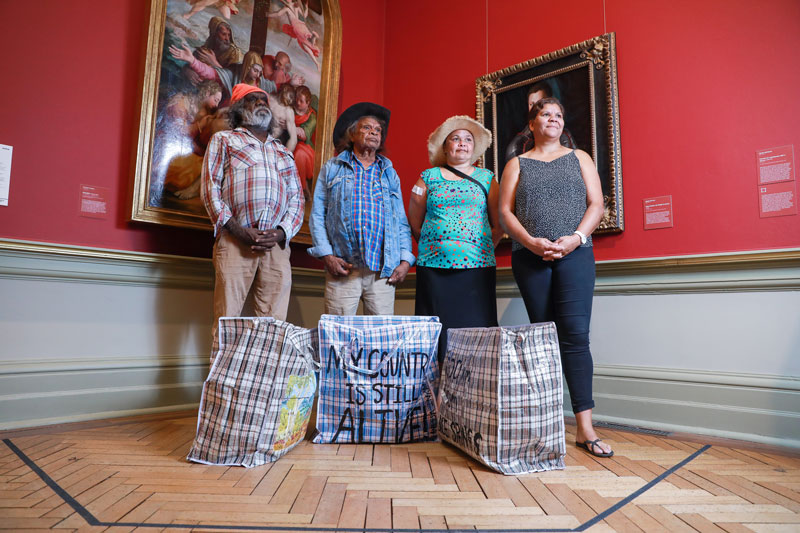
Iltja Ntjarra Many Hands is the art centre serving the Namatjira school of painters, many of them now living in Alice Springs while others are based in Ntaria (Hermannsburg). Their Homeless on my Homeland series had been installed at five Biennale venues across Sydney. The artists had worked on cheap checkered nylon‐weave bags of the kind often used by homeless people, spelling out short sharp political messages on one side and affixing paintings of their homelands to the other. “Every night worried for children and grandchildren,” read one message; “Family house full up,” read another. Set down seemingly casually in the art venues, their incongruity drew attention. With the virus spreading and anxiety building, the work was very relatable. It was also one more instance of these artists breaking with tradition to bring their message home.
Returning home early, a busy year lay ahead of them. They had already held a workshop, in collaboration with Charles Darwin University, to develop a new project, painting large landscapes on laser-cut metal screens for outdoor installation. While they adapted to the changing circumstances, this was work to be getting on with, including for their top-ranked artists who don’t hesitate to experiment with new materials, collaborate, work at greater scale, to undertake commissions and produce designs for merchandise. Meanwhile, in the office, staff prepared to shift various activities online, like the popular watercolour workshops the artists give at the Darwin Aboriginal Art Fair, and to upgrade their website and social media presence. To this end, arts worker Marisa Maher has been working on a click-through Family Tree that will allow people to see the connection to Albert Namatjira, whether by family line, or being taught by him.
Spread out in the spacious studio when I visited, Hubert Pareroultja was working on the fine detail of one of his delicately hued medium-sized watercolours, while Reinhold Inkamala was painting a series of four postcard-sized works. All of the artists will be doing some of these, to offer the market affordable works while money is tight. A landscape installation by Pareroultja in collaboration with Mervyn Rubuntja and Vanessa Inkamala has been selected as a finalist in the National Aboriginal and Torres Strait Islander Art Awards (“the Telstra”). It is painted on four two-metre lengths of silk that are hung to create a three-dimensional effect, as though you could walk into the Country it shows. Silk is an unforgiving ground on which to paint, as it is hard to erase any unwanted marks. Rubuntja was painting a new silk when I visited, understandably proud of mastering the technique and also tickled about the socks from the Iltja Ntjarra merchandise line that carry one of his designs.
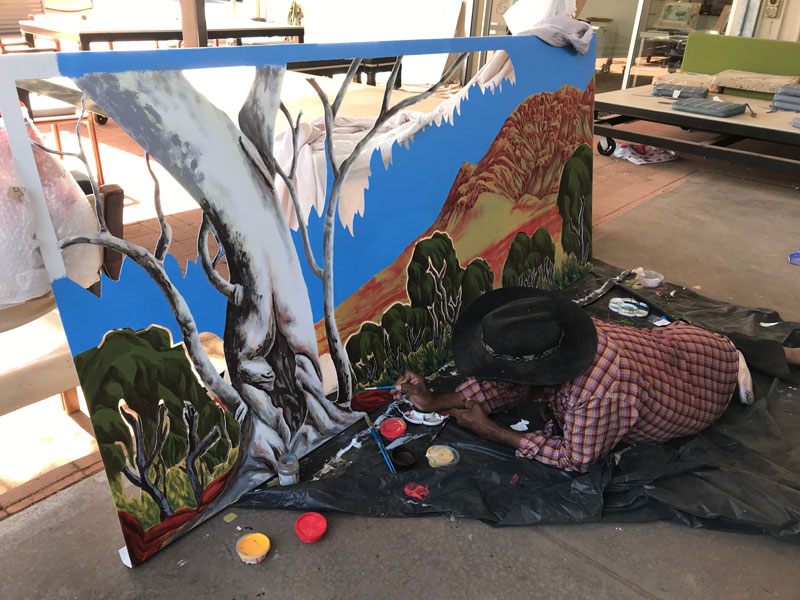
This readiness to do bread‐and‐butter work, alongside fine art work, is shared by many though not all art centres. At Tangentyere Artists, which supports artists living on Alice Springs Town Camps, manager Ruth McMillan explained it plainly: “For lots of people, painting money is their food money.” So finding ways to shore up income was where the town‐based art centres I spoke to turned their attention in the third week of March as Australia moved to close its borders to non-residents and introduce social distancing, and the alarm was being sounded about the urgency of protecting Indigenous Australians.
Tangentyere Artists, getting ready to hang a much-anticipated exhibition, closed their gallery to visitors on 16 March, and in the following week closed the studio. Painting materials for small works were sent home with artists, but most of them do not live in circumstances where they can paint larger works with the necessary peace, quiet and security. Staff poured their energy into creating a new website for their merchandise, Town Camp Designs, doing a stocktake, updating their database, streamlining their sales processes. Luckily, like Iltja Ntjarra, they had made an early start in the year, running a workshop in February in collaboration with artist Marina Strocchi for residents of Hidden Valley Town Camp. A raft of simple but striking black and white line drawings were produced, ideal for transposing onto a range of textile products, children’s t-shirts, hoodies, cushion covers, tea towels. It was all ready to go by early April, the site, the stock, the systems.
At the same time Tangentyere launched their exhibition online, beautiful figurative and non‐figurative work on the theme of rain falling and water flowing. After the initial shock of shutdown, they started accepting appointments for viewing, no more than two people at a time. They also prepared the studio to reopen for just four artists at a time, one in each corner, and with all the necessary hygiene practices in place. There’s a roster so everyone can get a turn. The prolific Sally Mulda though is a constant presence, bent quietly over her canvas continuing with her signature story-boarding of everyday camp life. She had a solo show at Raft Artspace in May, which would go ahead online.
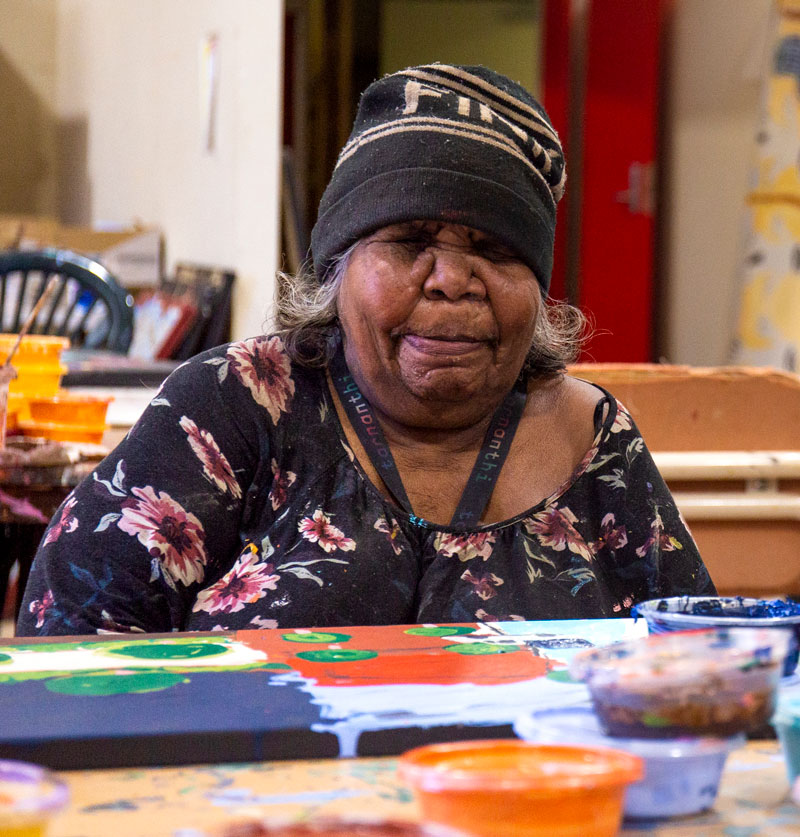
Along with Grace Robinya and Doris Thomas she was also a finalist in this year’s Alice Prize for which Robinya’s work was highly commended. This national contemporary art award was launched online but as NT internal restrictions start to ease, it looks set to open to the public. Unless there’s a turn for the worse, that will also be the case for the Telstra, for which Joanne Napangardi Wheeler is a finalist. These current bright spots reflect the hive of activity in the studio preceding the crisis, when there were between 18 and 24 people painting on any given day.
Demand thinned significantly after 26 March when Tangentyere Council, the governing body for Town Camps, went all out to get anyone with a home on a remote community or outstation to return to Country ahead of an internal lockdown in the Territory, restricting all but essential workers from travel onto Aboriginal lands. Some of the regular artists also live in Aboriginal hostels that have implemented strict coronavirus response regimes, requiring residents to stay at home except for essential requirements. Similarly, some of Iltja Ntjarra artists, like Gloria Pannka, returned to Country, while some are “staying at home” in the hostels.
Under the Tangentyere Artists umbrella, Yarrenyty Arltere has its own space on the Town Camp of that name (also known as Larapinta Valley) and has its own distinctive practice of soft sculpture. Because its studio operates within a community centre, all of which were closed by Federal Government fiat, it has not been able to do a limited re-opening. Instead staff go house to house to keep up sewing supplies and offer encouragement. But productivity has dampened. In their busy households, most of the artists are just managing to make small soft sculptures that will be sold through the Town Camp Designs site.
The shutdown has been a particular blow to Yarrenyty Arltere, as they had a 20th anniversary celebration show due to open at the Araluen Arts Centre in May. This was all about coming together as a community, the camp and the whole town, so there was no point in going online. Instead it will take place in 2021. For the past few years they have been putting together “looks” for the Darwin Aboriginal Art Fair’s textile arts feature, From Country to Couture, but this too has been postponed. (Other parts of the DAAF will go online, with the National Indigenous Fashion Awards and the Indigenous Curators symposium, Cultural Keepers, set to go ahead.) A July show in London has been cancelled but at least a September show in Brisbane is still scheduled as is Tarnanthi in Adelaide, giving them something to work towards.
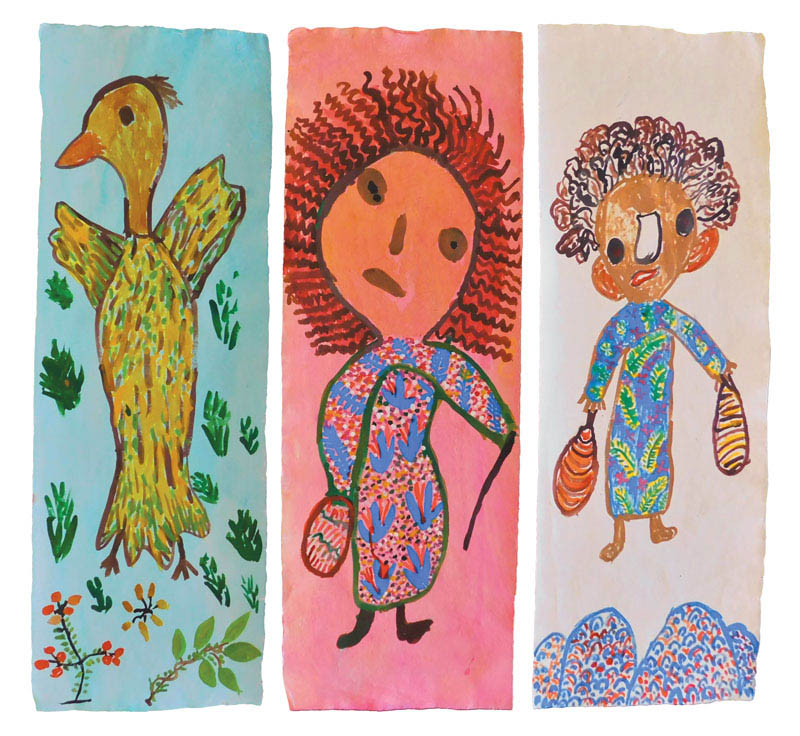
When I visited in late April news had just come through that travel restrictions for the outstations close to Alice Springs would be lifted. Manager Sophie Wallace was looking forward to visiting Trudy Inkamala who had been quarantined at her family outstation since 26 March. The eighty-year-old is finding it increasingly hard to sew but, in another workshop led by Marina Strocchi, has had a breakthrough, transposing the character and colour of her soft sculptures to works in ink on paper. Wallace did want to lose that momentum. Stalwart of Yarrenyty Arltere and its chairperson, Marlene Rubuntja, has also been extending her practice, sewing landscapes in soft bas-relief, intricately embroidered in brilliant colour.
Both Tangentyere Artists and Yarrenyty Arltere have new video projects in the pipeline, which they hope are sufficiently advanced to be able to complete with their collaborators at a distance, in readiness for possible outings at Tarnanthi, opening mid-October, and Desert Mob. This annual exhibition in Alice Springs of work from the desert art centres, the highlight of their year,[2] should be celebrating its 30th anniversary this September. What form this will take is still unclear. It looks likely that the physical exhibition and marketplace will be scaled back, and the symposium will go online, with celebrations pushed back to 2021.
The APY Lands had moved early in March to restrict incoming travel and this was hardened on 26 March when the Lands were designated a biosecurity area. At Mimili, the art centre, the only community-governed entity, acts as something of an information hub about the pandemic. “The community faces lots of issues at the best of times,” says manager Anna Wattler, “and they’re all amplified right now.” She works daily with Tuppy Goodwin, who is also the centre’s chairperson, both to get the community’s concerns heard by government and to feed back to the people on the ground. “There’s lots of new rules in Mimili now,” says Goodwin. “The young fellas are not allowed to go collect firewood, we can’t have church, or collect mingkulpa (bush tobacco), we can’t use cash, we can only buy little bit fuel on special days. I know how important it is to have strong rules now, but no one is explaining them to Anangu, and people are getting angry.”
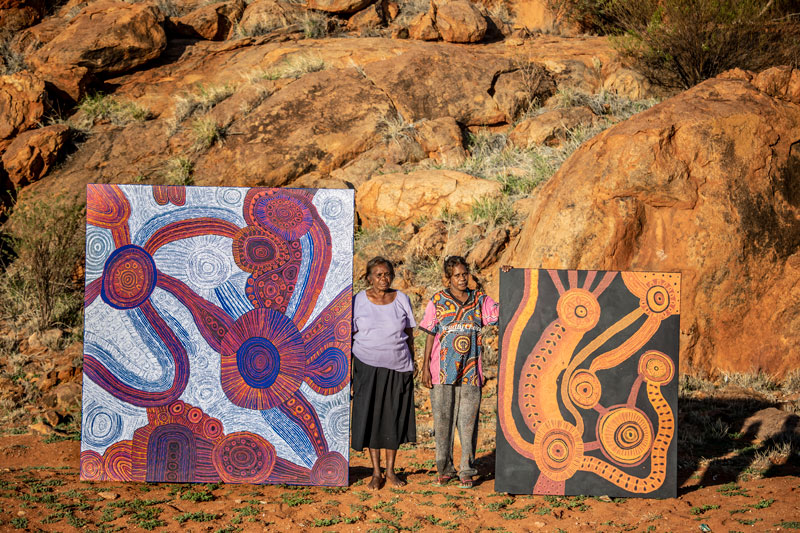
Goodwin has been writing letters, “trying to find out about this sickness and what it means for Mimili, talking to our friends in the cities to help us. At first government didn’t listen to us at all, but I even went on ABC News talking about how we need support to keep the old people safe. The clinic is small, two nurses for one community, no doctors. We cannot stay safe in Mimili when the sickness arrives.” But the artists want to keep working. Mainly elders are coming into the studio, working on big canvasses, at safe distances from one another, for a major project for 2021, still under wraps. “We can’t just sit home all day,” says Goodwin. “Our houses are too busy, maybe 15 people living in one house now. Government sent Anangu from the city back to Mimili now, and it’s really hard for us, because there is more family in the house, more people I need to buy food for. The young kungkas (women) work from home now, but us old people still work at the art centre.”
There’s uncertainty over smaller shows lined up for later this year, so the art centre is also using this time for an archiving project, bringing together the wealth of cultural knowledge and resources accumulated at the art centre over last 20 years: “This is a powerful thing to do in a time when many people are not able to afford art,” says Wattler. She is hoping to access grants to support the archiving work while they ride out the coronavirus wave. There’s no plan to produce work at the low-priced end of the market, for which they do very little at any time. It’s a small stable art centre, where artists are established in their careers. Younger artists work and learn alongside their Elders until they’re ready to emerge, like Marina Pumani Brown, a finalist in this year’s Churchie Emerging Art Prize, as well as in the Telstra in a collaboration with her mother Betty Kuntiwa Pumani, a past winner of the Telstra and the Wynne. (Mimili Maku’s Robert Fielding is also a Telstra finalist, and a past category winner.)
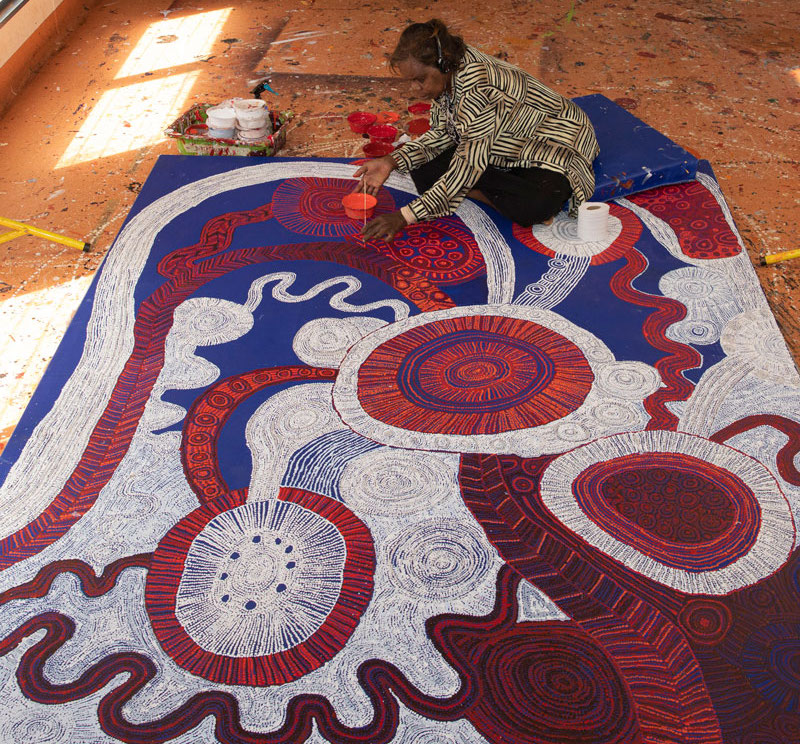
At Papunya Tjupi, expectations for the show at Raft Artspace were down-sized. There were eleven large canvases ready to go. They made a beautiful but more modest exhibition which went online. Painting for another show, at Outstation in Darwin, had not even begun when the centre closed its doors. The artists want to keep working but are looking at different approaches, at smaller scale work using more robust materials, adapting to what’s achievable from home. Linocuts to be printed by collaborators in Alice are among the possibilities. Arts workers also made up painting-from-home packs—paints, brushes, small linens, stretched and primed with transparent gesso. “The artists were thinking about the work they do on bush trips,” said Collard, “it’s less controlled, more messy and raw, brushes aren’t getting cleaned as much. They’re wanting to lean into their home environments and see what they come up with.”
When we spoke, arts worker Sharon Butcher had been caught by the sudden changes, visiting her sister in Barunga way to the north. The internal lockdown in the Territory would have made travel back to Papunya difficult if not impossible but in any case she felt too frightened, too worried about getting sick to try. She’d stay put. Collard was also preparing to leave temporarily, even though a return would mean two weeks in strict quarantine. After getting the artists organised and the art centre directors used to having board meetings by phone, she’d be able to work on building their new website just as well from Alice Springs: “With no-one painting here, it makes no sense for me to stay. It’s such a lonely place right now.”
Desart is the art centres’ advocacy body. Apart from helping them to negotiate the changes breaking upon them and to access the assistance available, CEO Philip Watkins has been turning his mind to recover He is heartened by research Desart had commissioned—before the coronavirus was even heard of—to better understand how the industry was faring after the damage of the global financial crisis.[3]3 The operational and financial data analysed, from 2004–05 to 2018–19, showed a slow but steady recovery back to where art centres were before the GFC, and that was with a reduced reliance on government funding in the last two years studied. This result is testimony to the oft‐referred to resilience of the movement and gives reason to their determination to keep working, making their exceptional art, through this ravaging new crisis.
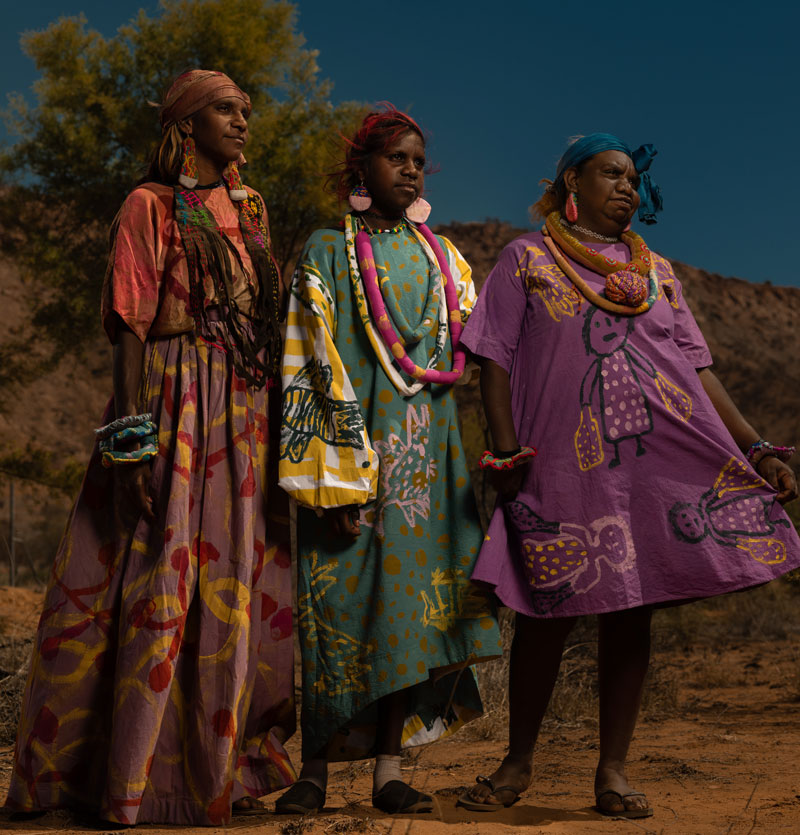
Footnotes
- ^ For more on this artist, see his memoir, Kulinmaya! Keep listening everybody!, which I reviewed for Artlink, 1 December 2019.
- ^ See my reviews of Desert Mob for the last two years, Artlink, 7 October 2019 and 27 September 2018.
- ^ Kieran Finnane, “Art centres: pushing back, pushing forward,” Alice Springs News, 9 April 2020.












